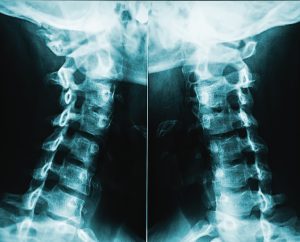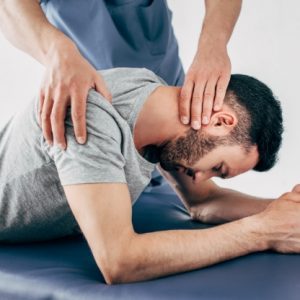
Compression Stockings: Benefits and Who Can Benefit from Them
19th March 2025
Whiplash is an acceleration‐deceleration injury to the neck. It may result from the impact of a motor vehicle collisions1,2 or during diving, among other mishaps2 . Symptoms such as neck pain but neck stiffness, dizziness, paresthesia/anesthesia in the upper quadrant, headache, fatigue3 and arm pain are commonly reported after the whiplash. However, Neck pain is considered as the chief Symptom1 . This quick back-and-forth motion can strain the neck muscles and ligaments, leading to various symptoms that can affect daily life. Recognizing these symptoms is essential for effective treatment and recovery.

X-ray image or radiography of human male neck vertebrae or cervical rachis.
The prognosis of a whiplash injury has been considered to be dependent upon several factors as listed below. Sounds confusing, yes it can be. Schedule an appointment today and we can help you go through the them. https://willowwellnessphysio.janeapp.com/
“Prognostic indictors of poor functional recovery following whiplash injury based on findings of systematic reviews.”1
| Factors showing consistent evidence for being prognostic indicators for poor recovery | Factors showing consistent evidence of not being prognostic indicators | Factors with inconsistent evidence |
| • Initial pain levels: >5.5/10 • Initial disability levels: NDI & gt; 29% • Symptoms of post- traumatic stress • Negative expectations of recovery • High pain catastrophizing • Cold hyperalgesia” |
• Accident related features (eg, collision awareness, position in vehicle, speed of accident) • Findings on imaging • Motor dysfunction |
• Older age • Female gender • Neck range of movement • Compensation- related factors |
WAD 1 No physical signs of dysfunction, Complaints of neck pain/tenderness / stiffness
WAD 2 Musculoskeletal signs and symptoms • Complaints of neck pain/tenderness/ stiffness-decreased range of motion, point tenderness
WAD3 Neurological signs and symptoms Musculoskeletal signs and symptoms. Complaints of pain, often radiating into and down the arm – decreased or absent deep tendon reflexes, muscle weakness, sensory deficits
WAD 4 Fracture or dislocation (revealed by radiographic studies) • Complaints of neck pain
Treatment for whiplash- Physical Therapy, A Cornerstone of Whiplash Treatment
Physical therapy is a key part of recovery, focusing on exercises that improve flexibility and strength in the neck and shoulders. These exercises may include gentle stretching, strengthening routines, and manual therapy techniques that target the specific muscles and ligaments affected by the injury.
In addition to exercises, physical therapists may use various modalities to aid recovery. Techniques such as heat therapy, ultrasound, and electrical stimulation can help reduce pain and inflammation associated with whiplash injuries5 . The goal is to facilitate a gradual return to normal activities while minimizing discomfort.
Physiotherapist may use the following to help treat a whiplash injury. The selection of the tools depends upon the classification of WAD and the timeline5,6 .
Don’t worry we will go over all the exercises in our follow up blogs and help you with your home exercise program!! Did you see our blog on the foam rolling to help with the postural tension in the mean time- https://www.willowwellnessphysio.ca/foam-rollers-self-myofascial-release-for-muscles/
The evidence-based recommendations for the treatment are as follows: The clinical guidelines list is extensive. We are discussing brief and important ones to help the general WAD injuries.
The management of WAD will depend upon if you are in the early acute stages (usually defined as 0–12 weeks) or a chronic condition has already developed (>12 weeks post-injury).

Whiplash has been associated with cognitive disturbances and mild traumatic brain injury7. It is important that the injury is assessed by an appropriate healthcare practitioner such as a Registered Physiotherapist.
An assessment to diagnose the WAD level and timeline of the injury is taken into the consideration to provide education and treatment options as outlined above.
Before you embark on an extensive gym sessions and juggle busy lives, schedule an appointment with the PT today so that we are not causing further harm.
Need to get assessed or still have questions, come and see me. We can chat, learn and assess the pain further and provide you with valuable educational resources and help resolve the pain with the effective Physiotherapy techniques. Call 604-533-1819 or book today at willowwellnessphysio.ca
Reference
1:Sterling M. Physiotherapy management of whiplash-associated disorders (WAD). J Physiother. 2014 Mar;60(1):5-12. doi: 10.1016/j.jphys.2013.12.004. Epub 2014 Apr 24. PMID: 24856935.
2: Verhagen AP, Scholten-Peeters GG, van Wijngaarden S, de Bie RA, Bierma-Zeinstra SM. Conservative treatments for whiplash. Cochrane Database Syst Rev. 2007 Apr
18;2007(2):CD003338. doi: 10.1002/14651858.CD003338.pub3. PMID: 17443525; PMCID: PMC8713438. https://pubmed.ncbi.nlm.nih.gov/17443525/
3: https://www.mayoclinic.org/diseases-conditions/whiplash/symptoms-causes/syc-20378921
4: DAVID M. WALTON, PT, PhD • JAMES M. ELLIOTT, PT, PhD . An Integrated Model of Chronic Whiplash-Associated Disorder. journal of orthopaedic & sports physical therapy | volume 47 | number 7 | july 2017. https://pubmed.ncbi.nlm.nih.gov/28622487/
5: https://www.physio-pedia.com/Whiplash_Associated_Disorders
6: Management of neck pain and associated disorders: A clinical practice guideline from the Ontario Protocol for Traffic Injury Management (OPTIMa) Collaboration. https://pubmed.ncbi.nlm.nih.gov/26984876/
7: André E. Bussières DC, PhD a b , Gregory Stewart BPE, DC c d , Fadi Al-Zoubi PT, MSc e , Philip Decina DC f , Martin Descarreaux DC, PhD g , Jill Hayden DC, PhD h , Brenda Hendrickson BN, MN i , Cesar Hincapié DC, PhD j , Isabelle Pagé DC, MSc k , Steven Passmore DC, PhD l , John Srbely DC, PhD m , Maja Stupar BSc, DC, PhD f , Joel Weisberg BSc, DC n , Joseph Ornelas DC, PhD The Treatment of Neck Pain–Associated Disorders and Whiplash Associated Disorders: A Clinical Practice Guideline, https://pubmed.ncbi.nlm.nih.gov/27836071/
Author: Meenie has been working as a musculoskeletal Physiotherapist with more than 10 years of experience treating musculoskeletal injuries, she has been practicing since 2016 in Canada. Meenie has a Masters in Science Physiotherapy which she completed with merit and was awarded the vice chancellor scholarship award. She is certified in both IMS, Vestibular and Concussion rehabilitation.
Medical Disclaimer:
The information presented in this blog post is for educational purposes and should not be interpreted as medical advice. If you are seeking medical advice, treatment or a diagnosis, consult with a medical professional such as one suggested on this website. Willow Wellness and the author of this page are not liable for the associated risks of using or acting upon the information contained in this article.